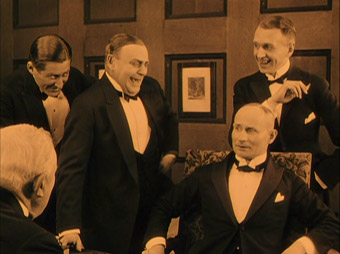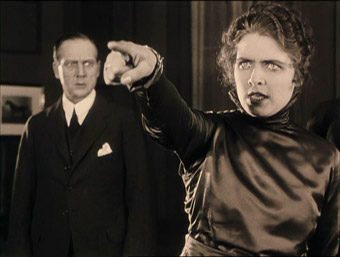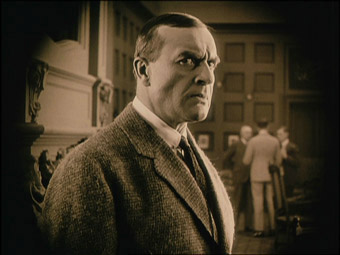|
It's funny how we always expect castles to be haunted, while the idea of a high-rise flat being host to a spirit is a relatively recent concept. Of course, castles are old and big enough for many to have died there, while some of the more poorly constructed tower blocks of the 50s and 60s were lucky if they lasted the lifetime of a single occupant. Castles also have lots of dark rooms and shadows, and even if you owned one you could almost guarantee there'd be corners you hardly ever got around to visiting. Who knows what might be lurking there at night? This belief that all castles have ghosts walking the battlements goes back to before the time such buildings were open to the public, which may well say something about the relationship between their occupants and those they oppressed to procure their land and wealth.
I'm getting a little sidetracked here, a diversion prompted by the English title of one of the oldest surviving films directed by Friedrich Wilhelm Murnau, who the following year would make Nosferatu, one of the finest and most important films in horror cinema history. So what of his 1921 The Haunted Castle? Could it be the Cabinet of Dr. Caligari-style expressionist horror suggested by the artwork on the DVD cover? A trial run for Nosferatu, perhaps? An exercise in gothic terror whose influence on later genre movies is only now being appreciated? None of the above? Ah, now you're getting warm.

The original German title, and the one more appropriately selected for this release, is Schloß Vogelöd, or 'Vogelöd Castle', and in case you're wondering what 'Vogelöd' means, it's simply the name of the building and its incumbent Lord. It's also not haunted, except by painful memories, but these belong not to the location but to two of the guests. Adding to the confusion is the building itself, which more closely resembles what we English would call a stately home than the commonly held view of what constitutes a castle. This is not a building in which to hold up and defend against invaders, but one where the wealthy gather to drink vintage cognac and smoke fat cigars.
Schloß Vogelöd is exactly as it claims in the opening titles, "The Revelation of a Secret" in five acts. A group of aristocrats have gathered at the eponymous castle for the October hunt, which has been delayed for days by persistent rain. Good thing too in my book. Arriving late and without an invitation is Count Johann Oetsch (a suitably sinister looking Lotar Mehnert), who was accused and acquitted of killing his brother Peter (an impressively restrained Paul Hartmann), but everyone thinks he did it anyway. The current Lord Vogelöd, a man named von Vogelschrey (Arnold Korff), appears to bear the Count no specific ill will, but chose not to invite him to avoid upsetting the Baroness Safferstätt (Olga Tschechowa), who was married to Peter at the time of his murder. She's since remarried, but three years on still wears the memory of Peter's death like a spiky millstone and remains firmly convinced of Oetsch's guilt. On arriving and learning of Oetsch's presence, the Baroness refuses to join the others and asks to confide in an ayatollah-bearded priest named Father Faramund (Victor Blütner), an old friend of Peter's. When Faramund disappears from inside a locked room, Oetsch once again becomes the chief suspect, but is soon pointing the finger at the suspiciously nervous Baron Safferstätt (Paul Bildt).
Intriguing though this all is, it does initially have the air of an efficiently filmed stage play, with none of the dynamic but always purposeful cinematic flourishes that characterise Murnau's later work. There's also little sign of the expressionism suggested by that poster and the vampire classic he was soon to make, either in the design of the castle interior or its evenly balanced interior lighting. There's hardly a shadow to be seen in many of these scenes, and it's almost as if some rooms were lit from above by banks of fluorescents.

Then, with the first of the Baroness's confessional flashbacks, everything changes. The inexpressive lighting of the castle interior gives way to some of the most poetically naturalistic imagery of the mid silent era (the first two shots of the first flashback are captivatingly backlit, a rare sight indeed for films of this period). Could this be the reason for the two credited cinematographers, Fritz Arno Wagner and László Schäffer? The purpose for this switch quickly becomes clear, to cinematically capture how vibrant and full of life the Baroness once was before being transformed by Peter's death into a joyless shell of her former self. No expressionism? Yeah, right.
What starts to emerge from the Baroness's confessions to Father Faramund is that her marriage to Peter was far from the initially suggested idyll, her increasing unhappiness the result not of domestic disagreement or infidelity, but of Peter's discovery and subsequent obsession with religion and spiritual purity. It's a rare thing indeed to find a film of this vintage that dares to suggest a down side to religious belief, though it is a little ironic that the Baroness chooses to confess her increasing unhappiness at her husband's obsession to a dedicated representative of the very same faith. Such is the nature of Catholic guilt.
Where the Murnau we know and love really does make his mark is in two mid-film dream sequences that appear to have been included purely the fun of staging them. The first is a nightmare in which a character identified only as 'the anxious gentleman' is terrorised in his bed by an overlong and monstrous clawed arm that reaches in through the window and drags him out into the night. A genuinely chilling image in its own right, it can't help but prefigure the predatory claw-like hands of Count Orlock in Nosferatu, particularly in the way its shadow precedes its arrival on its terrified victim's head. The second dream is altogether more playful in tone, with a young kitchen hand, who was recently scolded for helping himself to cream, given the chance to eat as much as he likes and repeatedly slap the chef who earlier chastised him. It's a sequence that has absolutely no bearing on the plot (you could remove it without affecting the main story in any way) and would appear to have been written in as light relief and is used by Murnau to experiment with the sort of trick photography he would later employ as a storytelling tool.

Even in the more pedestrian main story, there are enough points of interest to fuel scholastic debate. Murnau's command of cinematic storytelling is consistently assured and occasionally inspired, particularly in his use of medium close-ups and a sometimes expressive use of the Academy frame, such as the mid-shot of the Baroness pointing an accusatory figure at Oetsch (se the frame grab above), or the extraordinary hallway wide shot that vividly captures the emotional void that has developed between the Baroness and her future husband. The almost constant rainfall provides a convincing reason for the visitors' confinement and also works well in creating a sometimes ominous mood, and surprising though it will be to some, I was genuinely caught out by the last act twist, despite being provided with all I really needed to see it coming. And maybe it's just me, but I couldn't help thinking that the attention paid to the Baroness by von Vogelschrey's wife occasionally went a tad beyond that of womanly concern.
Schloß Vogelöd may be some way from classic Murnau, but is still a solidly made mystery drama that shines in the flashbacks and those mid-film pauses for the director to have some cinematic fun. There's even a little humour in one of the intertitles that should strike a chord with anyone old enough to remember how English summers often used to play out – after days of uninterrupted rain, the sun finally breaks out and the gathered guests set out on their hunt, only to be sent back by another downpour, which is announced by the words, "But, of course, after quarter of an hour..."
How far, one wonders, can Masters of Cinema go back and continue to deliver near pristine transfers? This version of Schloß Vogelöd was reconstructed in 2002 from an original negative from the Bundesarchiv-Filmarchiv in Berlin and a nitrate print with Portuguese subtitles from Fundação Cinemateca Brasileira, preserved at the Bundesarchiv-Filmarchiv in Koblenz. Most of the intertitles were obtained from the flash titles on the original negative and extended in length for the reconstruction, with missing intertitles taken from the shooting script and a preserved title list from the production company Decla-Bioscop. The reconstruction itself was a collaboration between the Berlin/Koblenz Bundesarchiv-Filmarchiv and the Friedrich-Wilhelm-Murnau-Stiftung, Wiesbaden.

The results, as ever with these restoration partners, are extraordinary. Give a little thought to what we're looking at here, a rarely seen German film from 1921, one that twenty years ago would likely have suffered from frame jitter and image flickering and be blighted by a sea of dust and scratches. And yet the image here is absolutely rock solid, displays only small variances in brightness and contrast, and is virtually spotless, with only the smallest traces of previous damage. The picture detail may not be up to the insanely high standard set by the Masters of Cinema Blu-ray of City Girl, but it's still impressive for a film of its age, and on close-ups is sometimes exceptional. The fine detail does blur a little on movement, but I'm pretty sure this is due to the adjusting the original frame rate (which during the silent era could be anything from 12 to 26fps, though 16fps was the most common) to the current European TV standard of 25fps.
The film has been tinted in accordance with original intentions, or at least an approximation of them. I have no doubt that informed decisions were made on the tinting of the picture here, but the level and colour of tint can vary quite a bit, sometimes on a shot to shot basis within the same scene. Picture detail is, as ever, at its strongest when the tinting is minimal or not applied at all. The booklet advises turning down the colour on your TV if you prefer to watch the film in black and white, but I think the tinting gives the castle interior at atmosphere that a purely monochrome image lacks. All in all, this is a superb restoration that again sets the standard for silent cinema DVD releases.
The Dolby 2.0 soundtrack consists of a piano accompaniment of the sort that might have been played on the film's original screening, and is as clear as you would hope from a modern recording.
The Language of Shadows (30:53)
A scholarly 2007 documentary by Luciano Berriatúa that explores Murnau's early career through archive stills, film extracts, narration, and interviews with his niece Eva Diekmann and relatives of his associates. There is quite a bit of scene setting before getting to the films, which includes the revelation that key influences were as diverse as Goethe, Poe, Molière, Shakespeare and Oscar Wilde. The main focus of the film coverage is Schloß Vogelöd, Der brennende Acker (1922), Phantom (1922) and Die Finanzen des Großherzogs (1924).
Booklet
As ever, the accompanying booklet is an invaluable companion to the film, and includes a detailed 1966 essay on the film by Charles Jameux, a useful excerpt from Lotte Eisner's 1973 Murnau that focuses specifically Schloß Vogelöd, a note on the tinting, credits for the film, poster reproductions and some well chosen stills, including the above-mentioned hallway wide shot, which Eisner describes as "one of the most beautiful pictures Murnau ever created." It's worth seeing the film before reading these essays, as there are spoilers contained within.
An engaging and technically solid early Murnau work that contains fascinating hints of things to come, and really comes to life in the flashbacks, dream sequences and later scenes. An absolute must for fans of early German cinema and the films of F.W. Murnau in particular, with the excellent restoration and the well targeted extras making this another impressive Masters of Cinema release. Recommended.
|